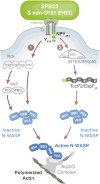Intimate host attachment: enteropathogenic and enterohaemorrhagic Escherichia coli
- PMID: 23927593
- PMCID: PMC4036124
- DOI: 10.1111/cmi.12179
Intimate host attachment: enteropathogenic and enterohaemorrhagic Escherichia coli
Abstract
Enteropathogenic and enterohaemorrhagic Escherichia coli use a novel infection strategy to colonize the gut epithelium, involving translocation of their own receptor, Tir, via a type III secretion system and subsequent formation of attaching and effecting (A/E) lesions. Following integration into the host cell plasma membrane of cultured cells, and clustering by the outer membrane adhesin intimin, Tir triggers multiple actin polymerization pathways involving host and bacterial adaptor proteins that converge on the host Arp2/3 actin nucleator. Although initially thought to be involved in A/E lesion formation, recent data have shown that the known Tir-induced actin polymerization pathways are dispensable for this activity, but can play other major roles in colonization efficiency, in vivo fitness and systemic disease. In this review we summarize the roadmap leading from the discovery of Tir, through the different actin polymerization pathways it triggers, to our current understanding of their physiological functions.
© 2013 John Wiley & Sons Ltd.
Figures



References
-
- Antón IM, Lu W, Mayer BJ, Ramesh N, Geha RS. The Wiskott-Aldrich syndrome protein-interacting protein (WIP) binds to the adaptor protein Nck. J Biol Chem. 1998;273:20992–20995. - PubMed
Publication types
MeSH terms
Grants and funding
LinkOut - more resources
Full Text Sources
Other Literature Sources

